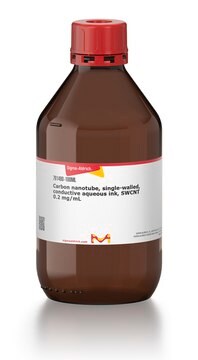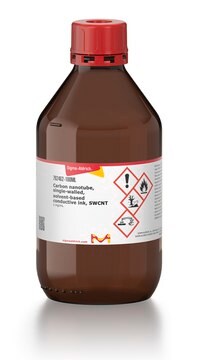791504
Carbon nanotube, single-walled
conductive aqueous ink, 0.9-1.1 mg/mL SWCNT(concentration by Absorbance at 854 nm)
Sinónimos:
CG300-Aqueous Ink, SWCNT Ink, SWNT Ink, SWeNT AC200, Single-Walled Carbon Nanotube Ink
About This Item
Productos recomendados
product name
Carbon nanotube, single-walled, conductive aqueous ink, 0.9-1.1 g/L (SWCNT concentration by Absorbance at 854 nm), avg. no. of layers, 1
form
dispersion in H2O (black liquid)
Quality Level
feature
avg. no. of layers 1
greener alternative product characteristics
Design for Energy Efficiency
Learn more about the Principles of Green Chemistry.
sustainability
Greener Alternative Product
concentration
0.9-1.1 g/L (SWCNT concentration by Absorbance at 854 nm)
sheet resistance
<600 Ω/sq, at 85% VLT (ohm/square) (by 4-point probe on prepared film by rod coating)
viscosity
3.0 mPa.s (at 10 sec-1 shear rate)
density
1 g/cm3
greener alternative category
, Enabling
General description
Application
Legal Information
Signis is a registered trademark of Chasm Advanced Materials, Inc.
CoMoCAT is a trademark of Chasm Advanced Materials, Inc.
CHASM is a trademark of Chasm Advanced Materials, Inc.
signalword
Warning
hcodes
Hazard Classifications
Aquatic Chronic 3 - Eye Irrit. 2
Storage Class
12 - Non Combustible Liquids
wgk_germany
WGK 3
flash_point_f
Not applicable
flash_point_c
Not applicable
Elija entre una de las versiones más recientes:
¿Ya tiene este producto?
Encuentre la documentación para los productos que ha comprado recientemente en la Biblioteca de documentos.
Los clientes también vieron
Artículos
The emerging field of printed electronics requires a suite of functional materials for applications including flexible and large-area displays, radio frequency identification tags, portable energy harvesting and storage, biomedical and environmental sensor arrays,5,6 and logic circuits.
Professor Rivnay (Northwestern University, USA) discusses using organic mixed conductors as an alternative to efficiently bridge the ionic world of biology with contemporary microelectronics.
A nanocomposite is typically defined as a mixture between a host material (e.g., polymer matrix) and nanofillers with at least one dimension of less than 100 nm.
Since its discovery little more than a decade ago,1 the two-dimensional (2D) allotrope of carbon—graphene—has been the subject of intense multidisciplinary research efforts.
Nuestro equipo de científicos tiene experiencia en todas las áreas de investigación: Ciencias de la vida, Ciencia de los materiales, Síntesis química, Cromatografía, Analítica y muchas otras.
Póngase en contacto con el Servicio técnico







